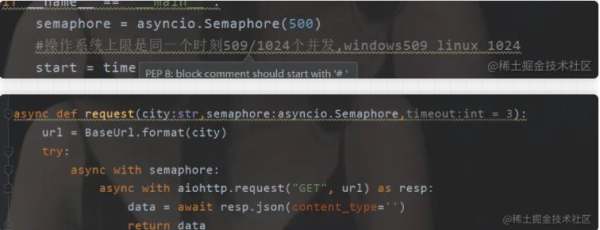这篇文章主要介绍了如何利用Python爬虫异步获取天气信息,用的API是中国天气网。文中的示例代码讲解详细,感兴趣的小伙伴可以动手试一试
前言
本来是想要更新scrapy的,但是怎么说呢,这玩意不难,看着官方文档,基本上就能做,主要是前面的如果你的爬虫基础不好的话,这个scrapy你也玩不好,而且对于大部分的人来说安装scrapy可能都是个问题,因为有一些历史遗留的问题,毕竟是从python2过来的老框架。当然还有个原因,我要做的东西,用不上scrapy,能够用上scrapy如果只是做爬虫,那必然是分布式爬虫,但是我这里要做的可能只是一个客户端,也就是一个spider采集软件,所以这个scrapy没法上。
目标
今天我们要搞的是获取天气,用的API是中国天气网。
BaseUrl = "http://wthrcdn.etouch.cn/weather_mini?city={}"网上呢也有很多,那个直接爬取中国天气网的爬虫,但是我就是搞不懂,为啥非要去网页里面然后去xpath或者正则去搞,明明用的都是同一个api出来的数据,我为啥要去页面把人家渲染后的结果去反向解析出数据?我直接拿数据不好嘛?
请求格式
回到这里,咱们的这个接口呢,是一个get请求,然后的话,那啥只需要把城市或者编号放在city那个字段就行了,返回结果是个json,我们把这玩意变成字典后是这样的
{'data': {'yesterday': {'date': '5日星期六', 'high': '高温 16℃', 'fx': '东北风', 'low': '低温 9℃', 'fl': '', 'type': '多云'}, 'city': '九江', 'forecast': [{'date': '6日星期天', 'high': '高温 12℃', 'fengli': '', 'low': '低温 7℃', 'fengxiang': '东北风', 'type': '中雨'}, {'date': '7日星期一', 'high': '高温 14℃', 'fengli': '', 'low': '低温 7℃', 'fengxiang': '北风', 'type': '多云'}, {'date': '8日星期二', 'high': '高温 19℃', 'fengli': '', 'low': '低温 8℃', 'fengxiang': '东南风', 'type': '晴'}, {'date': '9日星期三', 'high': '高温 21℃', 'fengli': '', 'low': '低温 11℃', 'fengxiang': '东南风', 'type': '晴'}, {'date': '10日星期四', 'high': '高温 23℃', 'fengli': '', 'low': '低温 11℃', 'fengxiang': '南风', 'type': '多云'} ], 'ganmao': '感冒多发期,适当减少外出频率,适量补充水分,适当增减衣物。', 'wendu': '8'}, 'status': 1000, 'desc': 'OK'}请求限制
这里不得不说一下,中国天气网 yyds 这个接口完全没有限制。为啥,我要做的是获取全国的天气信息,包括县城,中国大大小小几千个县城,而且还要分时段去分析,所以每天的请求访问至少2w起步。如果有限制的话,咱们就得那啥反反爬了,但是通过我的测试,没问题。
requests非异步获取
来,我们来先做一个对比,没有对比就没有伤害是吧,由于非常简单我就直接上代码了。
import requests from datetime import datetime class GetWeather(object): urlWheather = "http://wthrcdn.etouch.cn/weather_mini?city={}" requests = requests error = {} today = datetime.today().day weekday = datetime.today().weekday() week = {0:"星期一",1:"星期二",2:"星期三",3:"星期四",4:"星期五",5:"星期六",6:"星期天"} def __getday(self)->str: day = str(self.today)+"日"+self.week.get(self.weekday) return day def get_today_wheather(self,city:str)->dict: data = self.getweather(city) data = data.get("data").get("forecast") today = self.__getday() for today_w in data: if(today_w.get("date")==today): return today_w def getweather(self,city:str,timeout:int=3)->dict: url = self.urlWheather.format(city) try: resp = self.requests.get(url,timeout=timeout) jsondata = resp.json() return jsondata except Exception as e: self.error['error'] = "天气获取异常" return self.error def getweathers(self,citys:list,timeout:int=3): wheathers_data = {} for city in citys: url = self.urlWheather.format(city) try: resp = self.requests.get(url=url,timeout=timeout) wheather_data = resp.json() wheathers_data[city]=wheather_data except Exception as e: self.error['error'] = "天气获取异常" return self.error return wheathers_data if __name__ == '__main__': getwheather = GetWeather() start = time.time() times = 1 for i in range(5000): data = getwheather.get_today_wheather("九江") if((times%100==0)): print(data,"第",times,"次访问") times+=1 print("访问",times,"次耗时",time.time()-start,"秒")这段代码呢,我做了一个简单的封装。 我们来看看结果,5000次访问花了多久

这里我5000次重复访问的是同一个城市 九江
异步获取
这个代码的话我是没有封装的,所以看起来比较乱。 这里有几个注意点先说一下
系统上限
由于这个,异步的话还是使用的操作系统的一个底层嘛,所以这个并发是有上限的,因为这个协程异步是要不断切换的是吧。看起来有点像python自己的多线程,只是这个“多线程”完全是当IO的时候才会切换,不然不会切换。 所以哟啊限制一下

编码
import time import aiohttp from datetime import datetime import asyncio BaseUrl = "http://wthrcdn.etouch.cn/weather_mini?city={}" WeekIndex = {0:"星期一",1:"星期二",2:"星期三",3:"星期四",4:"星期五",5:"星期六",6:"星期天"} today = datetime.today().day day = str(today)+"日"+WeekIndex.get(datetime.today().weekday()) TIMES = 0 async def request(city:str,semaphore:asyncio.Semaphore,timeout:int = 3): url = BaseUrl.format(city) try: async with semaphore: async with aiohttp.request("GET", url) as resp: data = await resp.json(content_type='') return data except Exception as e: raise e def getwheater(task): data = task.result() return data def get_today_weather(task): global TIMES data = task.result() #得到返回结果 data = data.get("data").get("forecast") for today_w in data: if (today_w.get("date") == day): TIMES+=1#只有IO操作的时候才会切换,所以这个++操作还是一个原子性操作 if(TIMES%100==0): print(today_w,"第",TIMES,"次访问") return today_w if __name__ == '__main__': semaphore = asyncio.Semaphore(500) #操作系统上限是同一个时刻509/1024个并发,windows509 linux 1024 start = time.time() tasks = [] for i in range(5000): c = request("九江",semaphore,3) task = asyncio.ensure_future(c) task.add_done_callback(get_today_weather) tasks.append(task) loop = asyncio.get_event_loop() loop.run_until_complete(asyncio.wait(tasks)) print("耗时",time.time() - start,"秒")
到此这篇关于Python实战之异步获取中国天气信息的文章就介绍到这了,更多相关Python获取天气信息内容请搜索0133技术站以前的文章或继续浏览下面的相关文章希望大家以后多多支持0133技术站!
以上就是Python实战之异步获取中国天气信息的详细内容,更多请关注0133技术站其它相关文章!








